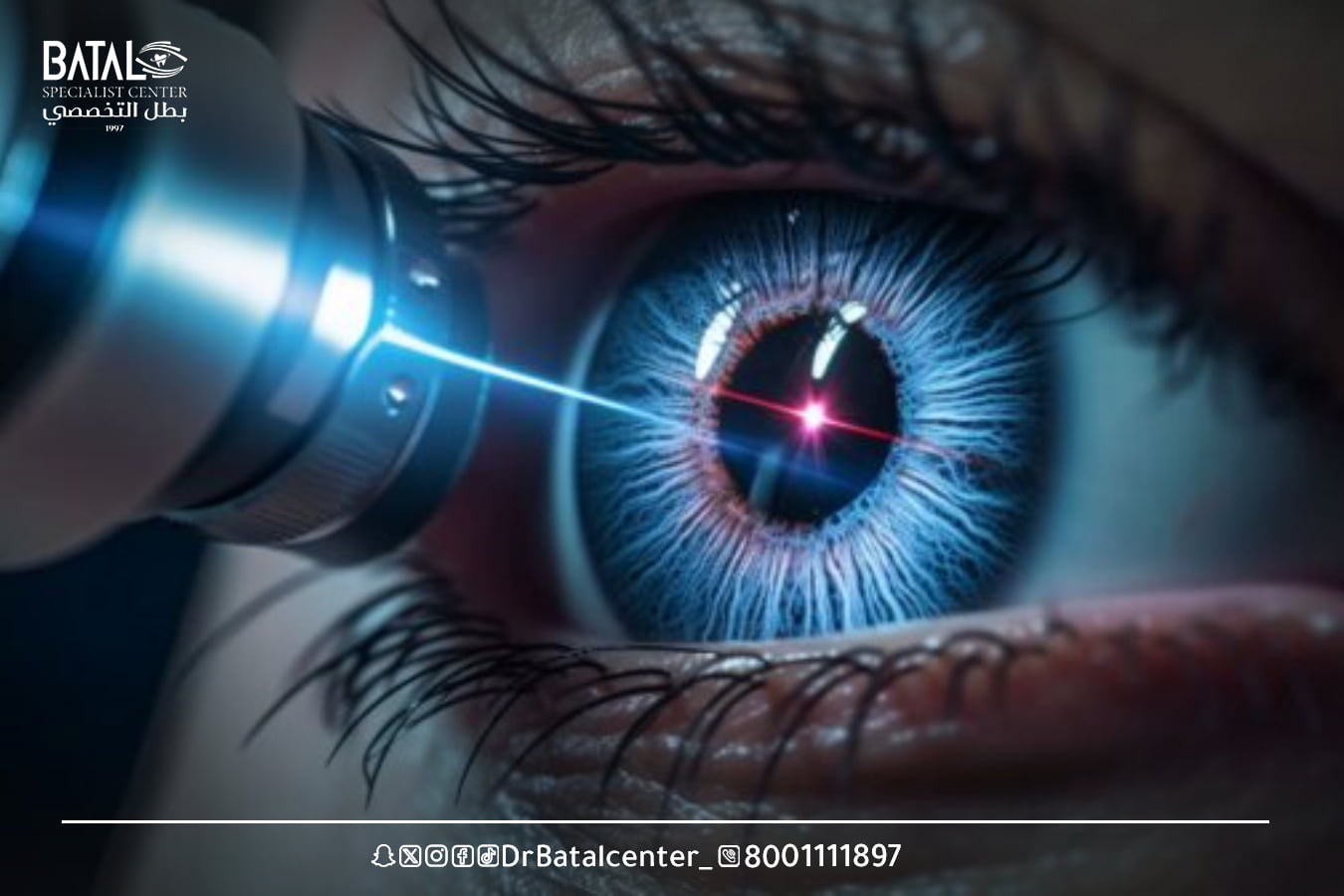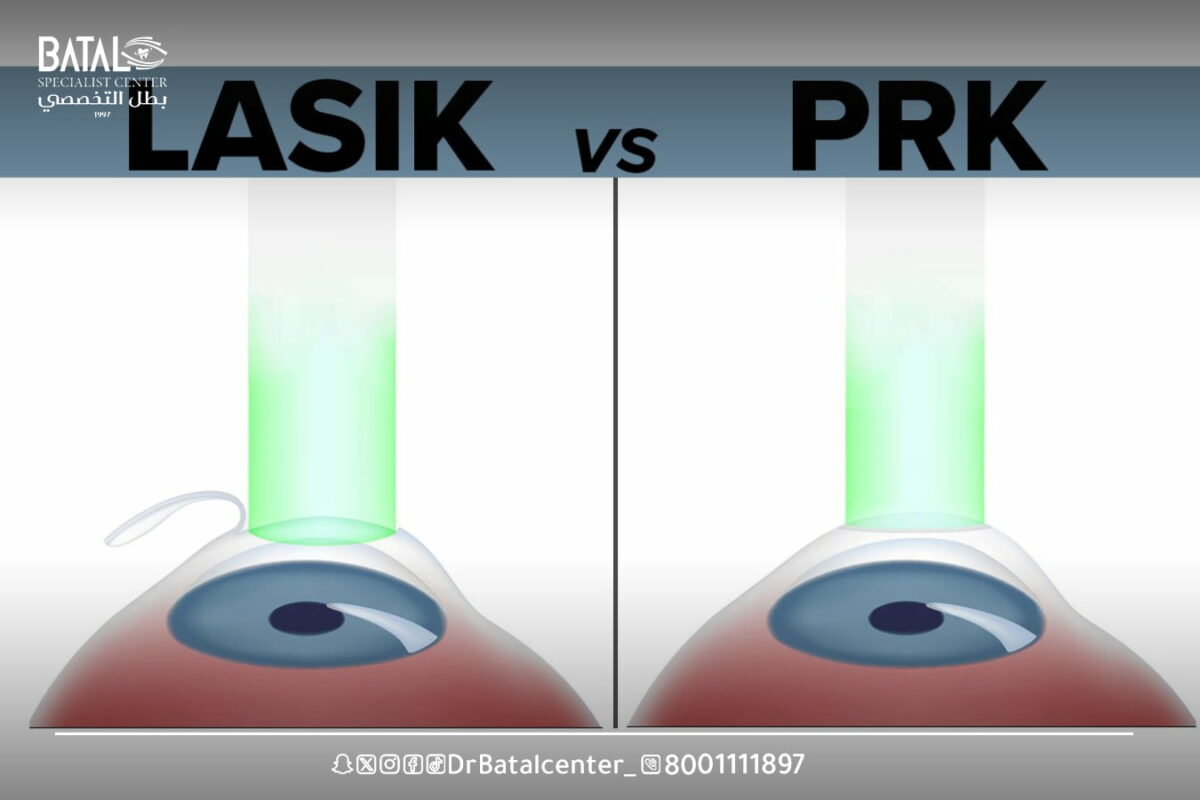Med info
PRK vs. LASIK: Achieve Clear Vision Without Glasses

For those seeking to break free from the constraints of glasses or contact lenses, laser vision correction procedures like PRK and LASIK offer life-changing solutions. These advanced, minimally invasive techniques harness the power of precise laser technology to reshape the cornea, and the clear front part of the eye, and correct refractive errors such as nearsightedness, farsightedness, and astigmatism.
PRK (photorefractive keratectomy) and LASIK (laser-assisted in-situ keratomileusis) are two of the most popular and widely performed laser vision correction procedures, each with its unique advantages.
Patients who undergo these transformative treatments can experience the freedom of clear vision without the need for corrective lenses, empowering them to embrace an active lifestyle and improved quality of life. With the guidance of skilled ophthalmologists in BatalEyeCenter Hospital in Jeddah and the latest advancements in laser technology, individuals can bid farewell to their glasses and embrace a future of visual independence.

What’s the Difference Between PRK and LASIK?
LASIK (Laser-Assisted in Situ Keratomileusis)
LASIK is a type of eye surgery. Before the surgery, the surgeon will assess your vision, examine your eyes, and guide the most suitable surgical option for you.
The LASIK procedure begins with your surgeon cleaning and numbing your eyes using drops. A device will be fitted to your eye to prevent blinking. While you may experience mild pressure or discomfort, you will not feel any pain during the procedure.
Next, the surgeon creates a small flap in the outermost layer of the cornea. An excimer laser is then used to reshape the cornea beneath the flap, correcting any issues that cause vision problems. Finally, the flap is replaced over the cornea.
- femto smile
- one day surgery center
- keratoconus surgery
- keratoconus surgery
- oculoplastic surgeries
- eye glasses gallery
- eyelid and tear duct surgery
- eye surgeries
- https:batal eye center comen eye clinics
- treatment and surgery of squint in children and adults
- How much does lasik eye surgery cost
- Laser Eye Surgery [options 2024]
- best eye hospital in saudi arabia
- best eye specialist in saudi arabia
PRK (Photorefractive Keratectomy)
The initial steps of PRK are similar to LASIK. Your eyes will be numbed with drops, and a device will be used to keep your eye still and prevent blinking.
However, in PRK, the surgeon completely removes the epithelium, the top layer of the cornea.
The excimer laser is then used to reshape the underlying corneal tissue, improving your vision.
Since the epithelium has been removed, a protective contact lens-like bandage is applied to the eye to facilitate the healing process until the epithelium grows back, typically within a week.

Choosing Between PRK and LASIK: Find Your Perfect Match
Comparison of the key factors to consider when choosing between PRK and LASIK eye surgery:
- Corneal Thickness
- PRK may be better suited for those with thinner corneas, as it removes the epithelium layer rather than creating a corneal flap.
- LASIK may be preferred for those with thicker corneas, as it preserves more of the corneal structure.
- Recovery Time
- PRK typically has a longer recovery time, as the epithelium needs to regrow after the procedure.
- LASIK generally has a faster visual recovery, as the corneal flap heals more quickly.
- Comfort Preference
- Some patients may find the PRK procedure more comfortable, as there is no corneal flap created.
- Others may prefer the LASIK approach, as it is generally considered less invasive.
- Age and Prescription Stability
- PRK may be preferred for younger patients or those with unstable prescriptions, as it avoids the creation of a corneal flap.
- LASIK can be a good option for those with more stable prescriptions.
- Consultation with a Qualified Ophthalmologist
- Ultimately, the decision between PRK and LASIK should be made in consultation with a qualified eye surgeon, who can evaluate your individual needs and recommend the most suitable procedure.
- No matter which option you choose, it is essential to have an in-depth discussion with your ophthalmologist to determine the best approach for your eye health and vision correction requirements.
Which is more effective: LASIK or PRK?
LASIK was first approved by the FDA in 1998 and has since become the most widely performed corrective laser eye surgery. PRK, on the other hand, was approved several years earlier, in 1995, and provides similar vision correction results to LASIK.
While LASIK and PRK are essentially identical procedures, the primary difference lies in how the surgeon accesses the corneal stroma. LASIK involves creating a corneal flap, which is then returned to its original position, while PRK removes the entire epithelial cell layer. Both methods provide the refractive surgeon access to the cornea, which is then reshaped using excimer lasers.
The choice between LASIK and PRK often comes down to meeting specific medical criteria and personal preferences. Both procedures utilize the excimer laser to access and reshape the cornea in a matter of seconds, with the entire procedure taking approximately 5-10 minutes per eye. Some patients may opt for PRK due to having thin corneas or a desire to avoid the corneal flap associated with LASIK, which can potentially lead to complications.
While the lack of a corneal flap in PRK may seem advantageous, patients should expect a longer and less comfortable recovery period compared to LASIK. The removal of the epithelial layer in PRK means it can take 4-5 days for the corneal surface to heal, with side effects such as eye dryness, itching, blurred vision, and light sensitivity during this period. These side effects will gradually subside, and vision will continue to improve in the weeks and months following the procedure.
Ultimately, neither PRK nor LASIK is inherently “better” than the other. The choice between the two procedures should be made in consultation with an experienced ophthalmologist, who can evaluate your specific eye health, corneal characteristics, and personal preferences to determine the most suitable option for your vision correction needs.
Does the military prefer LASIK or PRK?
The military prefers PRK over LASIK for their service members. The reasons include PRK’s greater corneal stability and suitability for thin corneas.
There are a few key reasons for this:
- Corneal flap stability: The LASIK procedure involves creating a corneal flap, which can potentially lead to complications, especially for those in active military service who may be involved in high-impact activities or combat situations. The PRK procedure, which doesn’t require a corneal flap, is generally seen as more stable and less prone to such complications.
- Recovery time: The recovery period following PRK is typically longer than LASIK, with 4-5 days needed for the corneal surface to heal. However, this extended recovery time is often preferred by the military, as it allows for a more gradual vision improvement and adaptation, which is important for combat readiness and performance.
- Suitability for thin corneas: Some service members may have naturally thin corneas, which can make them poor candidates for LASIK. PRK, on the other hand, is generally better suited for those with thin or irregularly shaped corneas.
Is PRK more expensive than LASIK?
No, The final cost of PRK versus LASIK can be influenced by several factors. In the LASIK procedure, the surgeon utilizes two separate lasers – one to create the corneal flap and another to reshape the cornea. In contrast, the PRK procedure requires only a single laser, the one used to reshape the cornea. Since fewer lasers are involved in the PRK process, can pass the lower cost to their patients.
When it comes to insurance coverage, both PRK and LASIK are typically considered elective surgeries and therefore are not covered by most insurance plans. However, there are financing options available that allow you to make payments over time.
While it may be tempting to seek out the cheapest or most discounted options for these vision correction procedures, it’s important to remember that this is a matter of your valued eyesight. Prioritizing the quality of care and the expertise of the surgeon should be the primary considerations, rather than solely focusing on the lowest price.
What are the disadvantages of PRK over LASIK?
Disadvantages of PRK over LASIK:
- Longer recovery time – It typically takes 4-5 days for the corneal surface to heal after PRK, compared to a faster 1-2 day recovery for LASIK.
- More discomfort during recovery – The corneal surface abrasion in PRK can cause more initial pain and discomfort during the healing process.
- Slightly less predictable visual outcomes – Studies have shown LASIK may provide slightly better visual acuity results compared to PRK for some patients.
How many years does PRK last?
PRK has been performed since the late 1980s, so it has been in use for over 30 years as a vision correction procedure.
Do Navy Seals get LASIK or PRK?
The military, including Navy SEALs, generally prefers PRK over LASIK. This is because PRK is seen as more stable and less prone to complications from the corneal flap created in LASIK, which is important for the high-impact activities and combat readiness required of special operations forces.
Which hurts more PRK or LASIK?
PRK is generally considered more painful than LASIK, especially during the initial recovery period. The corneal abrasion and surface healing process in PRK can cause more discomfort and require stronger pain medication compared to LASIK.
Conclusion
When it comes to laser vision correction, patients have the choice between two proven procedures: PRK and LASIK. Both techniques utilize advanced laser technology to reshape the cornea, but they differ in their approach.
PRK (photorefractive keratectomy) involves removing the outermost layer of the cornea, the epithelium, before using the laser to sculpt the underlying corneal tissue.
LASIK (laser-assisted in-situ keratomileusis), on the other hand, creates a thin, hinged flap in the cornea, which is then lifted to allow the laser to target the desired areas. While PRK may involve a slightly longer recovery time, it is an excellent option for individuals with thinner corneas or certain eye conditions that may not be suitable for LASIK.


